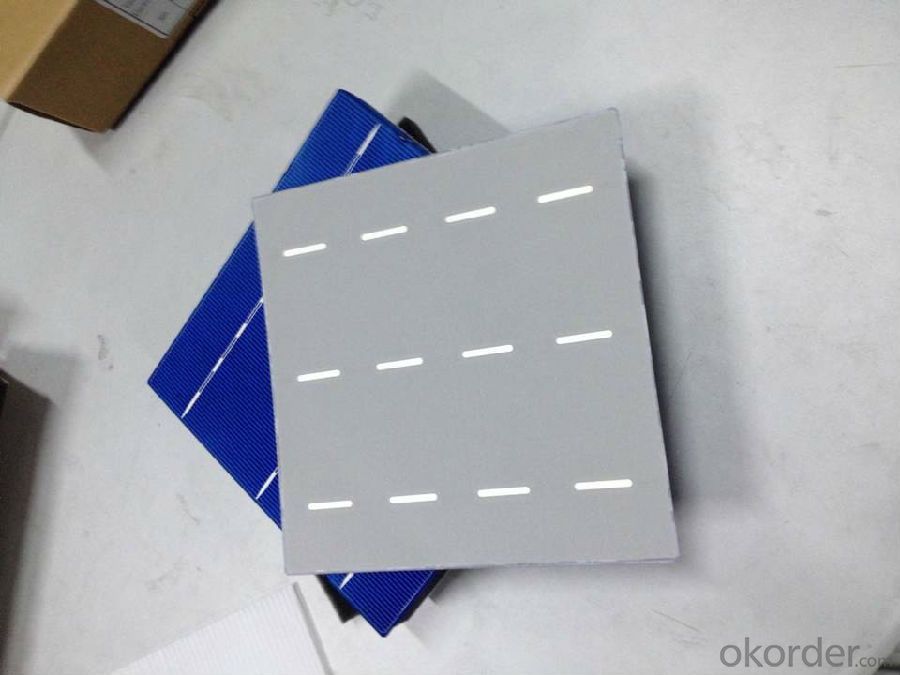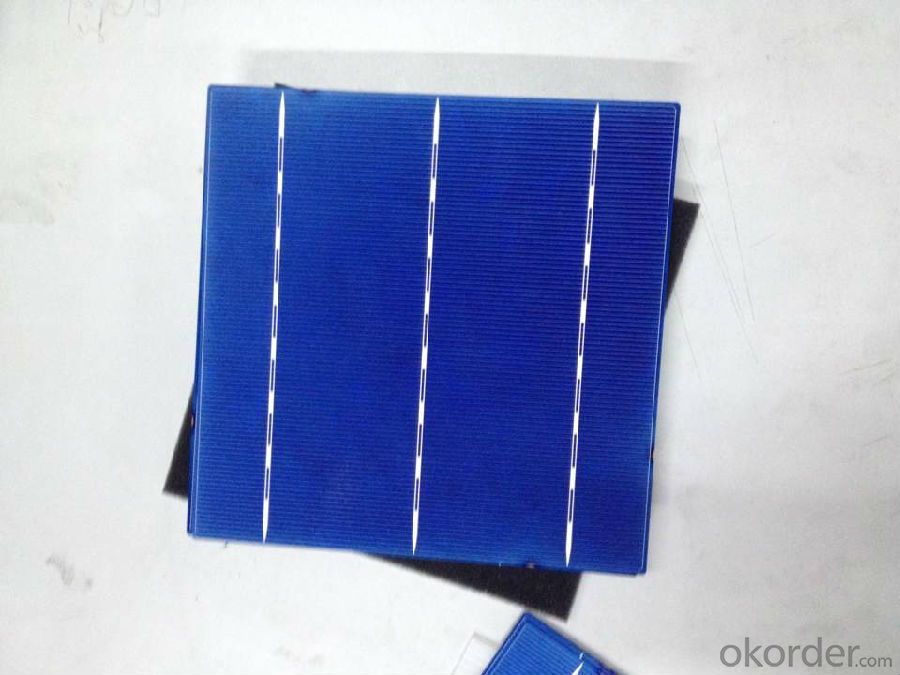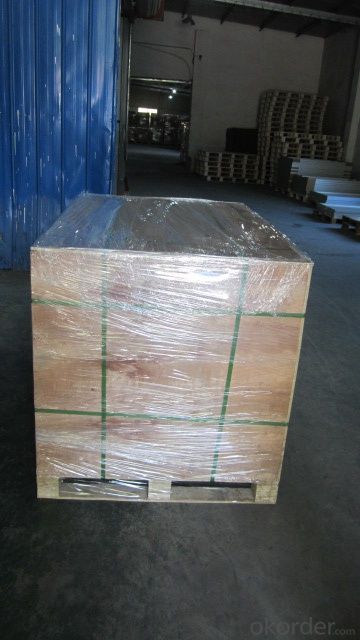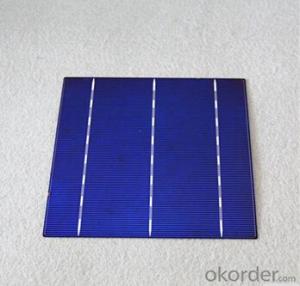Polycrystalline Solar Cells A GRADE High Efficiency 3BB 156*156mm
- Loading Port:
- Shanghai
- Payment Terms:
- TT or LC
- Min Order Qty:
- 5000 pc
- Supply Capability:
- 8000000 pc/month
OKorder Service Pledge
OKorder Financial Service
You Might Also Like
Polycrystalline Silicon Solar Cells:
Solar cells is made by solar wafer, it has three categories of solar cell right now, monocrystalline polycrystalline and thin film,These cells are entirely based around the concept of ap-n junction, which is the critical part of solar module, it is the part that can convert the light energy into electricity, the thickness is from 180um to 200um, with even busbars to conduct electricity, textured cell can decrease diffuse reflection; they are often electrically connected and encapsulated as a module. Photovoltaic modules often have a sheet of glass on the front (sun up) side, allowing light to pass while protecting semiconductor wafers from abrasion and impact due to wind-driven debris, rain, hail, etc. Solar cells are also usually connected in series in modules, creating an additive voltage. Connecting cells in parallel will yield a higher current;With high quality and stable quality. Our Cells can greatly improve the performance of Solar Modules.
Features
1.High conversion efficiency resulting in superior power output performance.
2.Outstanding power output even in low light or high temperature conditions
3.Optimized design for ease of soldering and lamination
4.Long-term stability,reliability and performance
5.Output power tolerance of +/-3%
Specification:
Mechanical data and design |
Format - 156 mm × 156 mm ± 0.5 mm |
Thickness- - 200 μm ± 20 μm |
Front (-) - 1.4 mm bus bars (silver),blue anti-reflection coating (silicon nitride) |
Back (+) - 2 mm wide soldering pads (silver) back surface field (aluminium) |
Temperature Coefficient of Cells |
Voc. Temp .coef.%/K -0.364%/K |
Isc . Temp .coef.%/K +0.077%/K |
Pm. Temp. coef.%/K -0.368%/K |
Efficiency code | Efficiency(%) | Pmax(w) | Impp(A) | Vmpp(V) | Isc(A) | Voc(V) |
182 | ≥18.20 | 4.43 | 8.26 | 0.536 | 8.71 | 0.634 |
180 | 18.0-18.2 | 4.38 | 8.22 | 0.533 | 8.68 | 0.632 |
178 | 17.8-18.0 | 4.33 | 8.17 | 0.530 | 8.63 | 0.630 |
176 | 17.6-17.8 | 4.28 | 8.12 | 0.527 | 8.60 | 0.627 |
174 | 17.4-17.6 | 4.23 | 8.08 | 0.524 | 8.56 | 0.625 |
172 | 17.2-17.4 | 4.19 | 8.05 | 0.521 | 8.53 | 0.622 |
170 | 17.0-17.2 | 4.14 | 7.99 | 0.518 | 8.49 | 0.620 |
168 | 16.8-17.0 | 4.09 | 7.94 | 0.515 | 8.45 | 0.618 |
Intensity Dependence |
Intensity [W/m2] Isc× [mA] Voc× [mV] Pmpp |
1000 1.00 1.000 1.00 |
900 0.90 1.000 0.90 |
800 0.80 0.99 0.80 |
500 0.50 0.96 0.49 |
300 0.30 0.93 0.29 |
200 0.20 0.92 0.19 |
IV Curve

Solar Panel Images:





Packaging & Delivery of Polycrystalline Solar Cells
Carton Box Package and Deliver by air. It should be noticed that it should be avoid of water, sunshine and moist.
FAQ
We have organized several common questions for our clients,may help you sincerely:
①What price for each watt?
It depends on the efficiency of the solar cell, quantity, delivery date and payment terms.
②How long can we receive the product after purchase?
In the purchase of product within three working days, We will arrange the factory delivery as soon as possible. The pecific time of receiving is related to the state and position of customers.Commonly 7 to 10 working days can be served.
③Can you provide the peripheral products of the solar panels, such as the battery, controller, and inverter? If so, can you tell me how do they match each other?
Yes, we can, we have two companies for solar region, one is CNBM International, the other is CNBM engineering Co.
We can provide you not only the solar module but also the off grid solar system, we can also provide you service with on grid plant.
④What is your warranty of solar cell?
Our product can promise lower than 0.3% open box crack, we support claim after opening the box if it has crackm color difference or sth, the buyer should give pictures immediately, we can not accept the claim after the solar cell has assembled to solar panel.
• Timeliness of delivery
• ⑤How do you pack your products?
We have rich experience on how to pack the solar cell to make sure the safety on shipment, we could use wooden box or pallet as buyer's preference.
⑥ Can you do OEM for us?
Yes, we can.
Space solar power station in space means that solar energy will be converted into electrical energy, transmission by wireless energy transmission to the ground, or simply to reflect sunlight to the ground, on the ground power systems. In the present research the United States, Russia, Japan and other countries. Its development prospects are very promising.
Characteristics of Space Solar Cells
The greatest feature of this system is green. Collect solar energy in space, the impact on the global environment is small and completely dependent on the earth's resources.
To build solar power plants in the ground, due to the influence of atmospheric absorption and scattering effects of sunlight to the ground after strong attenuation to 1.0 kW / square meter; and if the establishment of the space solar power station, the light intensity of 1.353 kilowatts / square meters, and 99% time of day, and therefore has a high power generation efficiency.
While the power generation efficiency space solar power plant is far above the ground. Continuously receiving solar energy from space cannot be affected by the season, such as diurnal variation, receiving high energy density, it is 7-12 times the average light power of the ground; while stably transmit energy to the ground, basically from the atmosphere.
Space Station on the technical principles has been no problem. Solar panels widely used in satellites, but in recent years, the power generation efficiency of solar cells, the conversion efficiency of microwave technology has made great progress, has laid a good foundation for the development of the system. But to achieve the industry standard applications, the requirements for power generation will be high, at least megawatts, G watt magnitude; solar panels may use to calculate the square.
- Q:Can solar cells be used for hydrogen production?
- Yes, solar cells can be used for hydrogen production through a process called photoelectrolysis, where the energy from sunlight is used to split water molecules into hydrogen and oxygen.
- Q:How do solar cells perform in high humidity environments?
- Solar cells typically perform well in high humidity environments. However, excessive moisture or prolonged exposure to water can lead to a decrease in their efficiency. It is important to ensure proper waterproofing and maintenance of the solar panels to prevent any potential damage caused by moisture.
- Q:How is the solar cells factories working in China? Do they follow certain quality standards?
- Yes, they follow the standard quality assurance protocol, and they are doing very well.
- Q:What are the advantages of using solar cells?
- One of the main advantages of using solar cells is that they harness renewable energy from the sun, which is an abundant and sustainable resource. Solar cells are environmentally friendly as they produce clean energy, emitting no greenhouse gases or pollutants. They also provide energy independence, reducing reliance on fossil fuels and decreasing energy costs over time. Solar cells require minimal maintenance and have a long lifespan, making them a cost-effective option in the long run. Additionally, they can be installed in remote areas where it may be challenging to access traditional electricity grids, providing electricity to communities that otherwise would not have access.
- Q:Can solar cells be used for military applications?
- Yes, solar cells can be used for military applications. They are increasingly being adopted by the military for various purposes such as powering field equipment, remote surveillance systems, and even to charge batteries for portable devices used by soldiers. Solar cells provide a reliable and sustainable source of energy in remote locations where conventional power sources may be limited or unavailable. Additionally, their silent operation and reduced logistical requirements make them well-suited for military operations.
- Q:Are solar cells affected by shade or partial shading?
- Yes, solar cells are significantly affected by shade or partial shading. Even a small amount of shade on a solar cell or panel can have a significant impact on its energy production. Shadows cast on solar cells can reduce their efficiency and overall power output, as shading prevents sunlight from reaching the shaded areas, thereby reducing the amount of energy that can be converted into electricity. Therefore, it is essential to ensure that solar panels are installed in areas where they can receive maximum sunlight exposure throughout the day to maximize their performance.
- Q:Can solar cells be used for powering remote data collection devices?
- Yes, solar cells can definitely be used for powering remote data collection devices. Solar cells are a sustainable and reliable source of energy that can be easily integrated into remote locations. They can efficiently convert sunlight into electricity, providing a continuous power supply to data collection devices. This eliminates the need for traditional power sources or frequent battery replacements, making solar cells an ideal solution for remote data collection operations.
- Q:Can solar cells be used for space applications?
- Yes, solar cells can be used for space applications. Solar cells are commonly used in space missions to convert sunlight into electricity, providing power to satellites, space probes, and even manned spacecraft. The abundance of sunlight in space makes solar cells an ideal and reliable source of energy for various space applications.
- Q:How do solar cells affect the local ecosystem?
- Solar cells have a minimal impact on the local ecosystem. While their installation may require clearing some vegetation and potentially disrupting wildlife habitats, once operational, solar cells do not emit any pollutants or greenhouse gases. Additionally, they do not consume water or generate noise, reducing their impact on local resources and wildlife. In fact, solar cells can even provide shading for plants and help reduce the urban heat island effect, contributing positively to the local ecosystem.
- Q:Can solar cells be used for powering telecommunications towers?
- Yes, solar cells can be used for powering telecommunications towers. They are a clean and sustainable energy source that can generate electricity to support the power needs of these towers. Solar panels can be installed on the towers or nearby to harness sunlight and convert it into usable power, reducing the reliance on traditional fossil fuel-based electricity.
1. Manufacturer Overview |
|
|---|---|
| Location | |
| Year Established | |
| Annual Output Value | |
| Main Markets | |
| Company Certifications | |
2. Manufacturer Certificates |
|
|---|---|
| a) Certification Name | |
| Range | |
| Reference | |
| Validity Period | |
3. Manufacturer Capability |
|
|---|---|
| a)Trade Capacity | |
| Nearest Port | |
| Export Percentage | |
| No.of Employees in Trade Department | |
| Language Spoken: | |
| b)Factory Information | |
| Factory Size: | |
| No. of Production Lines | |
| Contract Manufacturing | |
| Product Price Range | |
Send your message to us
Polycrystalline Solar Cells A GRADE High Efficiency 3BB 156*156mm
- Loading Port:
- Shanghai
- Payment Terms:
- TT or LC
- Min Order Qty:
- 5000 pc
- Supply Capability:
- 8000000 pc/month
OKorder Service Pledge
OKorder Financial Service
Similar products
New products
Hot products
Related keywords



























